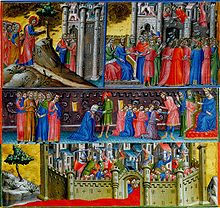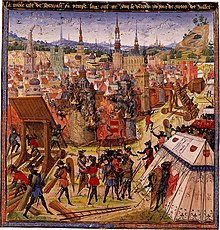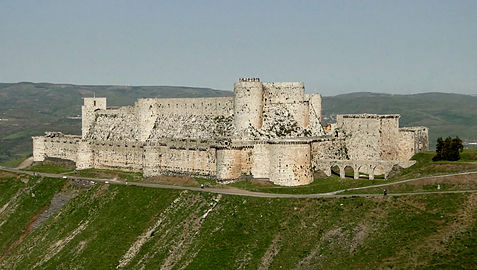Crusades
![]()
Crusader and Crusader are redirects to this article.
- See also crusader (disambiguation).
- For the company Crusaders, see Company Crusaders.
The Crusades were strategically, religiously and economically motivated wars sanctioned by the Latin Church between 1095/99 and the 13th century. In this narrower sense, the term refers to the Oriental Crusades, which were directed against the Muslim states in the Middle East. In the 13th century, the term for crusades (like peregrinatio) was also extended to other military actions whose goal was not the Holy Land (crux cismarina). In this extended sense, campaigns against non-Christianized peoples such as the Wends, Finns, and Balts, against heretics such as the Albigensians, and against the Eastern Church are also included. Occasionally, popes even called for crusades against Christian political opponents.
After a crusader army conquered Jerusalem in 1099, a total of four crusader states were founded in the Levant. As a result of their threat from the Muslim neighboring states, further crusades were undertaken, most of which met with little success. The Kingdom of Jerusalem suffered a heavy defeat in 1187 at the Battle of Hattin, and Jerusalem was also lost again. With Acre, the last crusader fortress in Outremer fell in 1291.
The term "crusade" goes back to the attachment of a sign of the cross to the clothing of those who took the crusader's oath. In contemporary sources, however, other terms were common, notably expeditio, iter and peregrinatio (as participants often also called themselves peregrini, emphasising the motif of an armed pilgrimage). The French term croisade dates from the 15th century (Occitan crozada around 1213), the German translation "Kreuzzug" is modern.

Symbolic representation of the conquest of Jerusalem (12th-14th century)
Motives of the crusaders and situation before the crusades
The Crusaders' motivation was by no means fed solely by religious zeal; rather, there were other reasons for their actions, which, moreover, changed over time. The individual motives were:
Religious motives
Building on Pope Urban II's call for crusades at the Synod of Clermont in 1095 (accompanied by the cry "Deus lo vult" - God wills it), many crusaders were convinced that by expelling the Muslims from the Holy Land they were fulfilling God's will and obtaining the remission of all their sins (indulgence, treasure of grace). This must be seen against the background of Christian reports and rumors of atrocities committed by Islamic rulers against the Christian population of the Holy Land, and the devastation of Christian sites, for example the Church of the Holy Sepulchre in Jerusalem in 1009. The Muslim chronicler al-Azimi, who came from Aleppo, also reports Muslim attacks on pilgrims, making access to the holy sites impossible. The preacher Peter the Hermit had also been mistreated by the Turks on an earlier pilgrimage to Jerusalem and forced to repent. In competition with economic interests, religious motives sometimes receded into the background over time - this is particularly evident in the conquest and sacking of the Christian city of Constantinople in the Fourth Crusade. With regard to the crusades to the Orient, however, they never completely disappeared, they also had a great influence on the Christian population in Europe.
Relationship with Islam
A major foreign policy problem for the Christian world was posed by Islam, which in its westward striving initially attacked the Christian Byzantine Empire in the middle of the 7th century. Within a few years, Ostrom/Byzantium lost the provinces of Syria and Egypt, which had been in religious opposition to the Greek and Latin empires since the Monophysite schism, to the Arabs, who were perhaps welcomed there as liberators by parts of the population (this is disputed in research); it continued, however, to assert Greek-influenced Asia Minor. Western North Africa resisted the Arabs until the end of the 7th century, while the Spanish Visigothic Empire collapsed within a few months under Arab storm around 700, so that the Arabs in the west were only stopped and pushed back by the Frankish Empire.
After the Byzantine Empire had been pushed out of central Italy by the Lombards in 751 (fall of the Exarchate of Ravenna), it was mainly limited to the Orthodox heartland of Asia Minor, the coasts of the Balkans and southern Italy at the beginning of the 8th century. Subsequently, in the 9th and 10th centuries, the empire found a modus vivendi with the Arabs, which even resulted in military alliances with individual Arab states. The military revival around the year 1000 was followed by an internal decline. With the Islamic Turkic people of the Seljuks, a new, expansive power entered the political stage of the Middle East at the same time, expanding at the expense of the Arabs and Byzantines. This led to military disaster for the Byzantines in 1071 in the Battle of Manzikert against the Seljuks, marking the beginning of the Turkish land grab in Anatolia.
In 1085, the Byzantine emperor Alexios IKomnenos, having repelled the Norman invasion of Epiros and Macedonia (with the aim of conquering Constantinople), finally left Asia Minor completely to the Seljuks in return for an oath of fealty, except for a few bases, so as not to be worn down between two opponents. After the victory over the Normans, Alexios asked the Pope for support to reconquer the Asia Minor empire, which by then had fragmented into several Turkish emirates, which Byzantine diplomacy played off against each other.
The great military effort of all Christian powers of the time can be explained by the fact that Islam was seen as a great danger - not only for the Byzantine Empire. After all, the Islamic-Arab area of power bordered on France at the Pyrenees; moreover, almost all the Mediterranean islands and parts of southern Italy had been temporarily conquered by Arabs. The latter were repeatedly attacked by them even after reconquest. Byzantine Sicily was conquered by the Arabs from 827, then by the Normans, until it fell to Henry VI in 1194, whereby the empire of the Hohenstaufen also directly bordered the Islamic sphere of power.
Relationship with Orthodoxy
The Oriental schism of 1054 strained the relationship between Orthodox and Catholic Christians from the beginning of the Crusades. Another aspect is the political relationship of the two leading powers of the Catholic and Orthodox world of states, respectively. The proper name of the German as well as the Byzantine empire was "Roman Empire", and the respective emperor derived from it a claim to leadership over the entire Christian world of states. Byzantium pursued an expansive western policy in the 12th century. Dynastic marriages with the Hungarian and German ruling dynasties, as well as military interventions in Italy with the aim of also gaining the (western) Roman imperial crown, were a basic constant of the foreign policy of the Byzantine Comnene dynasty. In order to push back the influence of Venice in the Byzantine Empire, Constantinople pursued a sharp anti-Venetian policy in the second half of the 12th century. This, of course, was not without reaction in Western Europe. The crusades were therefore increasingly directed not only against Islam, but at the same time more and more against the Orthodox, Greek-influenced Byzantium.
Nevertheless, the religiously motivated idea of crusading remained a recurring component of European politics in the period that followed, even if scholars sometimes emphasize that the crusading idea lost some of its force from the thirteenth century onwards (see the section on controversies in historiography above). On the whole, its importance in the late Middle Ages may probably not be overstated. Thus, a military expedition was considered in 1453 to defend Constantinople against Sultan Mehmed II. However, this half-hearted expedition started rather late, in April 1453, whereas the Sultan had already begun constructional preparations for a possible siege in the spring of 1452 and made no secret of this.
Whether one may place the concerted military assistance of Christian powers, such as the Holy Roman Empire and Poland, in the defence of Vienna in 1683 against the Turks in the crusading tradition is questionable. In 1528, in fact, an event occurred that had been unimaginable only a few decades earlier: France and the Ottoman Empire formed an alliance against the Habsburg Empire. At the latest with the integration of the Muslim state into the alliance system of the Christian powers, the unifying claim of the Catholic crusade idea in European politics ended.
Social factors in Europe
The occidental nobility hoped for new possessions through the conquest. This also and especially applied to the younger sons of the nobility, who were not entitled to inherit and now saw the chance to be able to rule over their own territory after all. This was also a goal of the church, since the peace of God was disturbed again and again by conflicts, in which it was primarily about territorial disputes. Thus, the crusades also provided a welcome occupation for the surplus sons who could not or did not want to be placed in the monastery or the clergy.
Large parts of the rural population saw the crusade as an escape from the harsh and often very unjust living conditions at home - especially since the Pope had promised an end to serfdom for anyone who would take up the cross and go with them to the Holy Land. The crusaders were joined in the procession by non-combatants: Women, clergy, the elderly and the poor.
Criminals and outlaws also responded to the calls because their crusading vows enabled them to escape prosecution and they hoped for a new life or booty.
Economic policy motives
Economically, the Italian maritime republics (Genoa, Pisa, Venice and others) also benefited from trade with the Orient. Thus, it was briefly considered to conduct a crusade to secure the spice route. However, the idea was dropped again quite soon.
The papacy expected a massive strengthening of its power position from control over the Holy Land. Ultimately, the popes probably also hoped for reunification with or control over the Eastern Church. In addition, with the beginning of the Fourth Crusade, economic interests also dominated. The best example of this motive is probably the Fourth Crusade itself, which was diverted from the commercial metropolis of Venice to Constantinople and resulted in plunder by the crusader army with the booty being transported to Venice in order to eliminate the trade rival. This shows the complete perversion of the originally religious crusade idea on the one hand, and on the other hand also a reason for the ever diminishing effect of the crusades in the defense of the Eastern Roman Empire.
The crusades were financed in the individual bishoprics through the crusade tithe. For this purpose, official books such as the Liber decimationis were created.
Other factors
The British historian Robert Bartlett sees the Crusades in a larger, pan-European context: In the 11th century, a strong population growth sets in, due to favorable climatic circumstances and new developments in agricultural technology. The population surplus leads to an expansion into the peripheries of Europe: the Iberian Peninsula, Ireland, Germania Slavica, the Baltic States and also into the Holy Land.

The capture of Jerusalem 1099. late medieval book illustration.

The Krak des Chevaliers in Syria
Classical counting of the crusades
In historiography, a total of seven crusades (Oriental Crusades) are distinguished as official crusades, although other acts of war also took place under the name 'crusade'. The counting is not entirely uniform in the literature, since some crusades are not unanimously evaluated as independent crusades.
Timeline
First crusade: 1096-1099, destination: Jerusalem
People's Crusade: 1096, Destination: Jerusalem
German crusade of 1096, target: actually Jerusalem
Crusade of 1101: Destination: Jerusalem
Crusade of Sigurd of Norway: 1108-1111, destination: Jerusalem/Sidon
Second Crusade: 1147-1149, destination: actually Edessa, ultimately Damascus
Wends crusade: 1147, target: Germania Slavica
Third crusade: 1189-1192, destination: Jerusalem
Crusade of Henry VI: 1197-1198, destination: Jerusalem
Fourth Crusade: 1202-1204, goal: actually Egypt/Jerusalem, ultimately Constantinople
Children's Crusade: 1212, Destination: Jerusalem
Albigensian Crusade: 1209-1229, Destination: Occitania
Fifth Crusade:
Crusade of Damiette: 1217-1221, destination: actually Jerusalem, ultimately Egypt
Crusade of Frederick II: 1228-1229, destination: Jerusalem
Crusade of Theobald IV of Champagne: 1239-1240, destination: Ascalon/Damascus
Crusade of Richard of Cornwall: 1240-1241, destination: Ascalon/Jerusalem
Sixth Crusade: 1248-1254, destination: Egypt/Jerusalem
Shepherds' Crusade of 1251: Destination: actually Egypt
Seventh Crusade: 1270, Destination: Tunis/Jerusalem
Crusade of Prince Edward: 1270-1272, destination: Acre/Jerusalem
Aragonese crusade: 1284-1285, destination: Girona
Shepherd crusade of 1320: destination: actually Andalusia
Crusade against Smyrna: 1343-1347, goal: Turkish principalities on the Asia Minor coast, containment of piracy
Crusade against Alexandria: 1365, destination: Egypt
Crusade against Mahdia: 1390, goal: containment of piracy
Crusade of Nicopolis: 1396, goal: containment of the Ottoman advance in Europe
The Swedish campaigns of conquest against the pagans in Finland in the 13th century are also referred to as crusades. In the 14th century, more than 50 crusades were conducted against the then pagan Prussians and Lithuanians. These campaigns, organized by the Teutonic Order, were also called "Prussian journeys" or "Lithuanian journeys". The 15th century shows four crusades against the Hussites. From 1443 to 1444, there was a campaign against the Ottoman Empire, usually classified as the "last crusade", which failed in the Battle of Varna.
Questions and Answers
Q: What were the Crusades?
A: The Crusades were a series of religious wars between Christians and Muslims that took place between 1096 and 1291, mostly in the Middle East.
Q: What was the purpose of the Crusades?
A: The main goal of the crusades was to gain control over the Holy Land, which is now known as Israel. This land is important for three major monotheistic religions - Islam, Judaism, and Christianity.
Q: How many large crusades happened during this time period?
A: There were nine large crusades that happened between 11th century and 13th century.
Q: Were there any smaller crusades?
A: Yes, there were also many smaller crusades that continued through 16th century until Renaissance and Reformation. Some even occurred within Europe (for example in Germany, Austria, Scandinavia and France).
Q: What does "crusade" mean?
A: The word "crusade" is related to the word "cross", and means a Christian holy war. Muslims sometimes use the Arabic word “jihad" to describe these wars.
Q: When did Muslim forces take control of Jerusalem?
A: Muslim forces had taken control of Jerusalem during Caliphate of Umar in 7th century.
Q: What are some important religious sites located in Holy Land?
A:Some important religious sites located in Holy Land include Dome of Rock, Western Wall, Temple Mount, Mount of Olives as well as many others.
Search within the encyclopedia